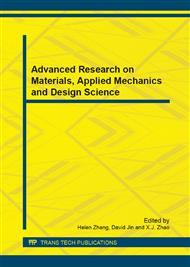[1]
Huijing, P.A., Toussaint, H.M., Clarys, J.P., Groot, G., de., Hollander, A.P., Vervoorn, K., Mackay, R., Savelberg, H.H.C.M., (1988). Active drag related to body dimensions. In: Ungerechts, B.E., Reischle, K., Wilke, K. (Eds.), In Swimming Science V. Human Kinetics Books, Champaign, Ill, p.31–37.
Google Scholar
[2]
Kolmogorov, S.V., Duplishcheva, O.A., (1992). Active drag, useful mechanical power output and hydrodynamic force coefficient in different swimming strokes at maximal velocity. Journal of Biome-chanics 25, 311–318.
DOI: 10.1016/0021-9290(92)90028-y
Google Scholar
[3]
Toussaint, H.M., Roos P.E., Kolmogorov,S., (2004).The determination of drag in front crawl swimming. Journal of Biomechanics37,1655–1663.
DOI: 10.1016/j.jbiomech.2004.02.020
Google Scholar
[4]
Toussaint, H.M., Truijens, M., (2005). Biomechanical aspects of peak performance in human swimming. Animal Biology 25, 17–40.
DOI: 10.1163/1570756053276907
Google Scholar
[5]
Berger, M.A., de Groot, G., Hollander, A.P., (1995). Hydrodynamic drag and lift forces on human/arm models. Journal of Biomechanics 2, 125–133.
DOI: 10.1016/0021-9290(94)00053-7
Google Scholar
[6]
Thayer, A.M., (1990). Hand pressures as predictors of resultant and propulsive hand forces in swimming. Ph.D. Dissertation, University of Iowa, Iowa City, Iowa.
Google Scholar
[7]
Sanders, R.H., (1999). Hydrodynamic characteristics of a swimmer's hand. Journal of Applied Biomechanics 15, 3–26.
Google Scholar
[8]
Taïar, R., Sagnes, P., Henry, C., Dufour, A.B., Rouard, A.H., (1999). Hydrodynamics optimization in butterfly swimming: position, drag coefficient and performance. Journal of Biomechanics 32, 803–810.
DOI: 10.1016/s0021-9290(99)00066-4
Google Scholar
[9]
Vennell, R., Pease, D., Wilson, B., (2006). Wave drag on human swimmers. Journal of Biomechanics 39, 664–671.
DOI: 10.1016/j.jbiomech.2005.01.023
Google Scholar
[10]
Bixler, B.S., Schloder, M., (1996). Computational fluid dynamics: an analytical tool for the 21st century swimming scientist. Journal of Swimming Research 11, 4–22.
Google Scholar
[11]
Bixler, B., Riewald, S., (2002). Analysis of swimmer's hand and arm in steady flow conditions using computational fluid dynamics. Journal of Biomechanics 35, 713–717.
DOI: 10.1016/s0021-9290(01)00246-9
Google Scholar
[12]
Rouboa,A.,Silva,A.,Leal,L.,Rocha,J., Alves,F., (2006). The effect of swimmer's hand/forearm acceleration on propulsive forces generation using computational fluid dynamics. Journal of Biomechanics 39, 1239–1248.
DOI: 10.1016/j.jbiomech.2005.03.012
Google Scholar
[13]
Gardano, P., Dabnichki, P., (2006). On hydrodynamics of drag and lift of the human arm. Journal of Biomechanics 39, 2767–2773.
DOI: 10.1016/j.jbiomech.2005.10.005
Google Scholar
[14]
Bixler, B., Pease, D., Fairhurst, F., (2007). The accuracy of computational fluid dynamics analysis of the passive drag of a male swimmer. Sports Biomechanics 6, 81–98.
DOI: 10.1080/14763140601058581
Google Scholar
[15]
Zaïdi., H., Taïar., R., Fohanno., S., Polidori., G., (2008). Analysis of the effect of swimmer's head position on swimming performance using computational fluid dynamics. Journal of Biomechanics 41, 1350–1358.
DOI: 10.1016/j.jbiomech.2008.02.005
Google Scholar
[16]
Zaïdi.,H.,Taïar.,R.,Fohanno.,S.,Polidori.,G., (2010). Turbulence model choice for the calculation of drag forces when using the CFD method. Journal of Biomechanics 43, 401–411.
DOI: 10.1016/j.jbiomech.2009.10.010
Google Scholar


